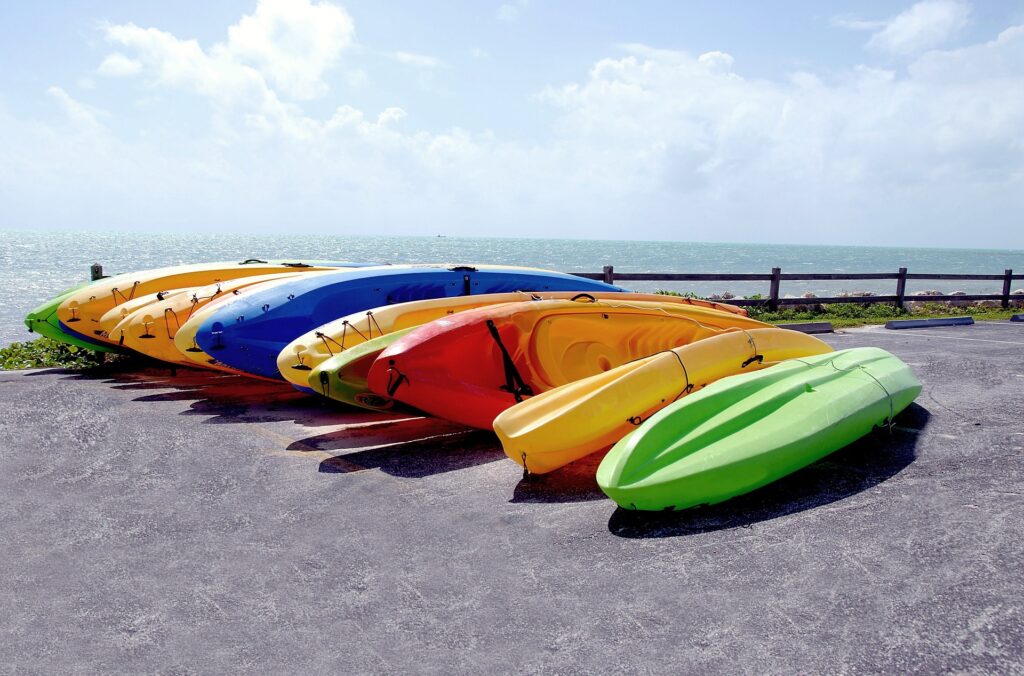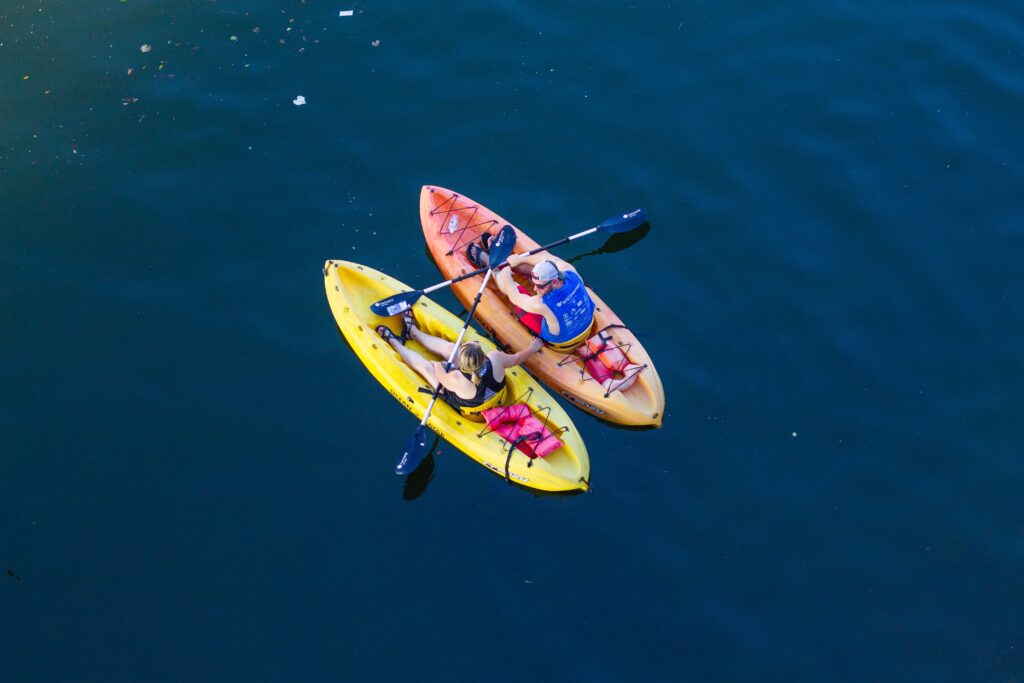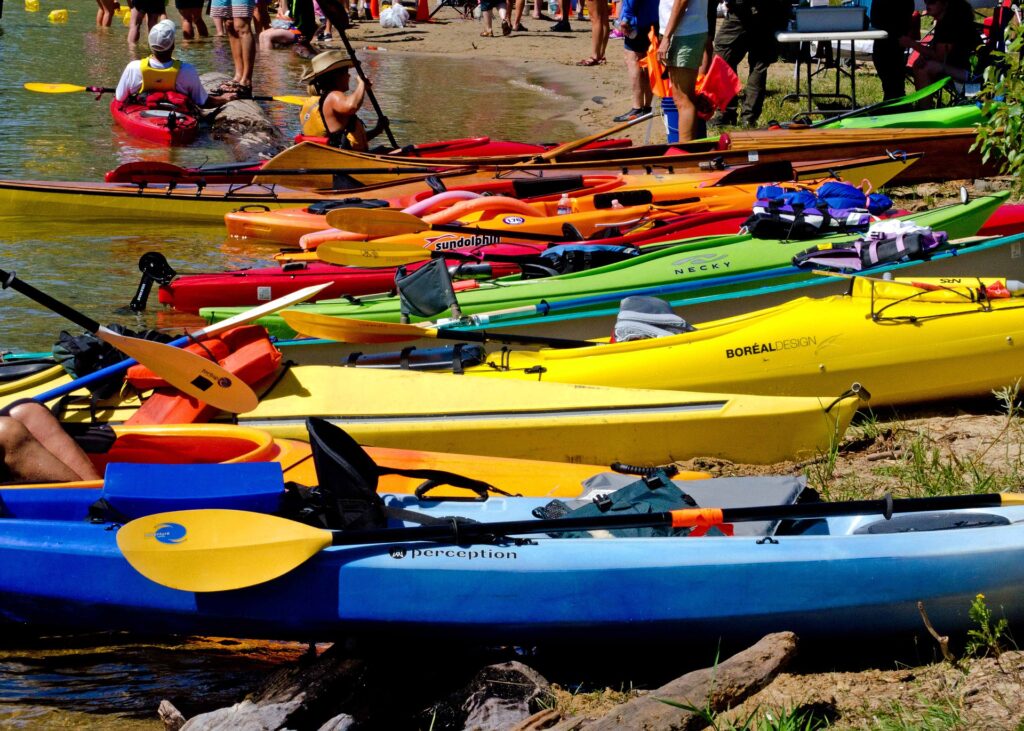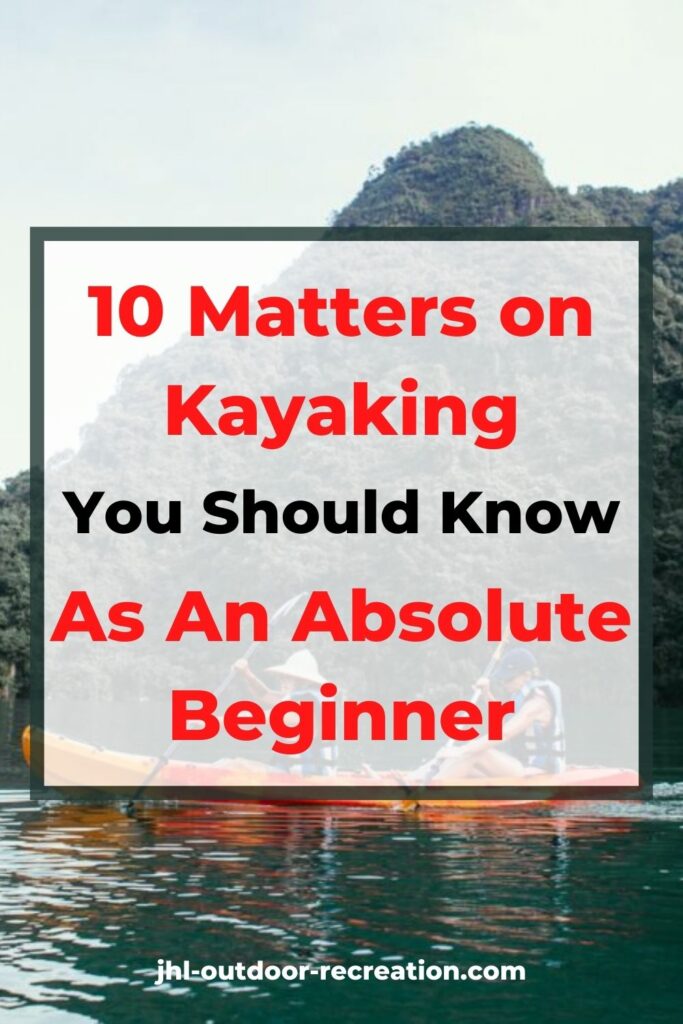Ok, you have probably heard of kayaking and you want to give it a try. But, you may be hindered from doing this because you don’t know how to kayak at all. What can you do in respect of kayaking for beginners?
Relax. Kayaking is safe even for beginner who doesn’t know how to swim!
Thus, this post is dedicated to the absolute beginners with ZERO experience in kayaking.
However, even if you are a beginner, this doesn’t mean that you should straight away head to rent a kayak and start kayaking.
In fact, you need some basic ideas before you start kayaking. Check out some of the matters and tips that you should be aware of which relates to kayaking for beginners.
1. Where do you want to kayak?

I assume that you don’t have a personal kayak. If otherwise, you wouldn’t be a beginner, right? – But, if you have a friend who is a kayaker, maybe you can borrow his kayak or you guys can kayak together.
Google search or ask your friends to check the places that provide kayak rental. Most probably you need to know the location and the price of kayak rental. – I believe you don’t want to select the “cheapest” option but you need to travel for 2-3 hours just to rent a kayak.
Also, technically you could kayak on lake, river and even ocean. But, for an absolute beginner, the “safe” option would be the LAKE. – Always remember this is the first rule of kayaking for beginners to kayak on calm water.
Because the conditions to kayak on river and ocean are much more hectic! – You would only need to attempt these when you have solid experience in kayaking.
2. Who should you kayak with?

Ideally, you should go kayaking with a person who knows about kayaking because he knows the basic stuff and can give you some basic guidance.
But, if you don’t have THAT person to accompany you, you could go with your friends or family members.
No matter what situation is, as a beginner, never ever go kayaking ALONE! Could you imagine if anything happens when you are paddling, and you don’t know what to do and nobody can help you?
3. Weather
Another tips on kayaking for beginners. Go kayaking on a sunny day, hands down!
Before that, check the weather first. If the weather forecast shows cloudy day and there is a chance of raining, then you better change your plan.
As a beginner, you want to experience the joy and fun of kayaking, and you could only enjoy it when the weather is permissible.
Don’t be too adventurous, for now, ok? – Unless you have an experienced kayaker to kayak with you, and he knows exactly what you guys will do.
4. Kayaking gear and equipment
As compared to my earlier post on hiking gear and equipment, kayaking gear and equipment are relatively simpler.
Generally, wear and bring necessary items according to the condition. – That is, for the weather and the water.
Those gear and equipment that you might need to bring:
Sunglasses
You’ve probably seen those professional kayakers wearing the fancy sunglasses and they look super cool.
Of course, this is not the main purpose to wear sunglasses. You know that sunglasses are used to protect the eyes from the glaring sunlight.
In addition, sunglasses are also used to protect the eyes from the water splash. Once you start paddling, you know water splash is soooo common. – And is soooo uncomfortable when the water enters your eyes!
Water-resistant sunscreen
You probably think: why not bringing “waterproof” sunscreen?
So, you go to search for waterproof sunscreen. And you come across this “water-resistant” sunscreen and you immediately discount this option.
But the truth is, “waterproof” sunscreen doesn’t really exist. Hence, it makes water-resistant sunscreen to be the best choice for kayaking. – Well, literally you need this for all watersport activities and don’t waste your time hunting for “waterproof” sunscreen.
Ok. But, what about Sun Protection Factor (SPF)?
You heard this before; the higher the SPF is, the better the protection is. As a minimum requirement, you should have a water-resistant sunscreen with SPF 15.
Hat
You are going to kayak on a sunny day. But, sometimes thing happens unexpectedly and it may rain when you are kayaking.
You need a hat. – A hat to protect you from the sun and also the rain.
There are two common types of hat which are suitable for kayaking:
Sun hat / rain hat
You are able to tie the hat under your chin, so when the wind is strong, your hat wouldn’t be blown away.
Cap
If you don’t have a sun hat / rain hat, it’s alright! – Cap is the next option.
Not as good as a sun hat / rain hat, but at least it can protect you from the sun.
Non-cotton clothing
As what I had suggested in my earlier post for hiking, cotton clothing is actually a big “No no” for any kind of sport, because of its terrible efficiency in drying the clothes.
Ideally, you should wear synthetic fabric clothing because of its quick drying ability. – You need this because of the water splashing from paddling and your sweat.
One of the most important tips in kayaking for beginners is to wear for water, rather than weather. So, you should consider wearing wet suit or dry suit. Apart from that, this clothing usually comes with long sleeves clothing to cover up your arms so that you can avoid sunburn and unattractive tan line.
Footwear
Thinking that kayaking is purely an upper body activity and it has nothing to do with your feet? And, you don’t bother to consider what shoes to wear for your kayaking? – You are absolutely wrong!
Let’s think about it: you need to step in and out the kayak, right?
Here comes the reason that you need to consider the proper footwear for kayaking.
When you enter or exit a kayak, you may step on a rocky or slippery surface. So, proper footwear can prevent your feet from injury and slipping to the water.
The suggested shoes for kayaking include
- Specific water shoes
- Sandals
- Skin shoes
- Neoprene boots
- Old trainers
As a beginner, you may not have some of the above “fancy” shoes. It’s fine, because I think you have sandals or old trainers at least, right? – So, it is really not an excuse to have improper footwear for a beginner.
Or, you want to act “cool” and don’t mind to be miserable, go ahead with
- Barefoot
- Walking boots
- Flip flops
Water bottle
Nothing is worse than craving for water when you are disastrously thirsty because of the vigorous paddling, and the sweating under the hot sun!
Always prepare 1 to 2 litres of water for your kayaking. – Unless you want to drink the lake water?
First aid kit
Alright, you bring this just in case any thing happens. It does no harm at all.
Dry bag
This is a waterproof bag that is created to put in your necessary and electronics items. It is commonly used for water sport activities.
Don’t have to worry about your house key, wallet, smartphone, and car key. Just put them inside your dry bag and bring it to kayak.
Oh, and don’t forget to put the first aid kit inside your dry bag as well.
Whistle
This is not for joy or entertainment; this is for safety purpose.
Refer to the Safety section below on how to equip and use a whistle properly.
And, please don’t use the whistle to flirt with other paddlers. – It is not cool and it’s super dumb!
5. Kayak rental

A typical kayak rental should include kayak, personal flotation device (PFD) and paddle.
Some kayak rental shops may provide locker facilities to allow you to put in your personal belongings. It’s ok if this is not available, because you can put those things inside your dry bag.
Well, if kayaking class is available at the kayak rental shop, I highly encourage you to take a kayaking class before you start to kayak.
However, don’t be discouraged if the class is not available. It is fine that you don’t know how to kayak at all. – Although you need some time for trial and error.
And, your kayaking session should be around 1 to 2 hours. – More than that will be exhaustive because of the paddling.
6. Enter and exit kayak
Tips on kayaking for beginners: you can enter and exit your kayak via shore or dock.
To me, entering and exiting via shore is much safer because it is more stable than entering and exiting via dock.
Entering and exiting via dock, however, places emphasis on balancing on the water and you may fall into the water if you lose your balance.
In this case, your friend may need to help you to enter the kayak. – That is also why you need somebody to go kayaking with you.
Notwithstanding this, you can ask the assistance of the kayak rental shop to guide and help you to enter and exit the kayak.
For better understanding, check out the video below.
7. Paddling
This is quite technical which we could explore further in future because I don’t want to flood you with technical matters.
As kayaking for beginners, just enjoy and explore kayaking first and only fine tune your technique later on.
Take a look on the paddles around. The paddles may be different from each other: the direction of the both blades of the paddle is the same (aka unfeathered paddle), whereas the direction of the blades is tuned in certain angle or even perpendicular (aka feathered paddle) to one another for other paddle.

Why is there a difference between these paddles? – There are different purposes for both paddles.
Which one should you use?
For now, don’t have to be selective and just use the paddle given to you. Let’s say you are given a feathered paddle, you can easily switch to unfeathered blade paddle, by simply adjusting the shaft, if you don’t feel comfortable using it.
Next, there are some matters which you could observe for your first “adventure”:
Paddle holding
First, put the centre of the shaft above your head. Hold each side of the shaft with your grip. Then, you are holding it right when the angle of your elbows is around 90 degree.
Next, try not to hold the shaft too firmly as shown in the video below. This helps you paddling.
Posture
Always remember to sit tall and don’t lean your back. – Although you may be tempted to lean your back even if it is just a recreational kayaking.
And, when you are paddling, remember to rotate your torso. This may sound odd to you because you think that kayaking is all about shoulder and arm.
Maybe you can think of swimming front crawl. You know that torso rotation is important to improve hydrodynamics. – This applies to kayaking as well!
Strokes
There are FOUR fundamental strokes for kayaking; forward stroke, reverse stroke, sweep stroke, and draw stroke.
As a beginner, you need to be aware of the types of stroke which you could experience yourself when you are paddling. – You don’t need to “master” this yet, for now.
To make it more relatable to you, try to think of kayaking as driving a car and how each stroke relates to how we drive. Also, try to imagine the motion of moving through water by applying Newton’s Third Law of Motion.
– Forward stroke
Immerse the blade in the front of water to catch water and navigate the blade to the back to create a forward motion. Rotate your torso and paddle the other side. – Main stroke amongst the rest, certainly!
– Reverse stroke
Opposite of forward stroke: Immerse the blade at the back to catch water and navigate the blade to the front to create a backward motion. Rotate your torso and paddle the other side, too.
– Sweep stroke
Make a full range semi-circular paddling on your left side if you want to turn your kayak to the right. Likewise, do the same on your right side if you want to turn to the left.
– Draw stroke
Draw your kayak to the side that you want by immersing the blade, facing parallel to the kayak. Pull the blades toward you to enable your kayak move against the direction of your pull. – This is commonly used when you want to steer your kayak to other kayak or the shore.
Let’s check out this video for your better understanding on paddling.
8. Safety
Although kayaking is considered as a safe watersport, its safety measure shouldn’t be ignored.
That is why we need to put on the PFD before we start kayaking, even if you are good at swimming! In fact, this is not only related to kayaking for beginners, but also experienced paddlers.
Hence, whistle is suggested to bring along for kayaking. And, whistle should be attached to the PFD, NOT hung around your neck.
Since you just start kayaking, ideally, you should paddle close to the shore.
Once you are comfortable with paddling, you could proceed further and explore a bit. – But, make sure you are still within the vision of the people on the land.
In case of capsizing, meaning the kayak is overturned, you will be “thrown” to the water. – Although the chance is reallllllllllllllly slim.
But, don’t panic! – Trust the PFD, and you will be surfaced to the water. Try to stay close to your kayak.
If you are strong enough, you could flip the kayak back to its original position and try to climb back to the kayak.
If otherwise, use your whistle to ask for help and stay close to your kayak. Other paddlers or the workers at the shop should hear this and come to rescue you.
9. After kayaking
Imagine you are preparing food for cooking, then you start to cook, and then you start eating. After eating, you know something has to be done, still. – Because you still have to wash the dishes and clean the table.
Same goes to kayaking. After you have finished paddling and exited the kayak, you need to clean the “mess”.
Don’t leave the paddle and the kayak just like that, as if they “know” how to go back “home” themselves. Although the workers may settle for you, you can take initiative to do this yourself.
First, put the paddles back to its original position or return to the workers.
Next, empty the water inside the kayak. For a sit-on-top kayak, you just need to flip the kayak to drain it and flip it back to original position. For a sit-in kayak, however, you need to use a cup or a pump to clear the water out from the kayak.
10. Warm up and warm down
Kayaking is still a vigorous exercise even if it is only for recreational purpose, as it works extensively on your shoulders and arms.
If you don’t want to experience shoulders and arms pain the next day, spend a few minutes to warm up and warm down for your pre- and post-kayaking session.
Just try it. Don’t set high expectation
You look at the kayakers paddling gracefully in a straight line. You admire them and yet you may feel embarrassed because you have no experience in kayaking, at all! Lemme tell you: kayaking is not always for experienced paddle, kayaking for beginners are equally possible.
Don’t set high expectation on your first kayaking session. Your first kayaking session might be clumsy – you may not know how to navigate your kayak properly and your kayak moves in a “zig-zag” pattern.
But, that is totally FINE! – That is the reason that you need to experience it!
For every stroke of paddling, you are actually learning and unlocking a new skill, and you can see your improvement when you keep paddling.
Who knows you might develop a passion in kayaking?
Relevant posts

Pingback: Kayaking Efficiency: How to Improve Your Technique – John Low